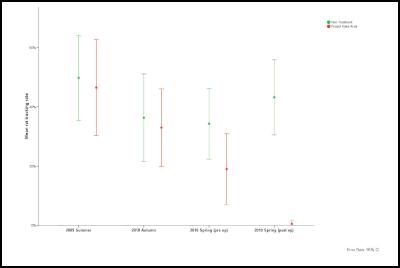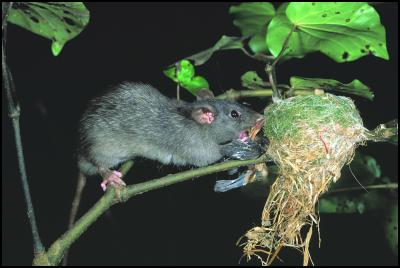Plenty to sing about in the Tararua Forest Park
Plenty to sing about in the Tararua Forest Park
17 December 2010
Rat numbers have plummeted following a 1080 operation as part of Project Kaka, an on-going pest control programme to restore the health of a wide range of wildlife and plant species and control bovine tuberculosis (TB) in the Tararua Forest Park.
“Rat monitoring before and after the operation has shown a significant decrease in rat tracking rates in the 30 000 hectare treated zone,” said Chris Lester, Department of Conservation Wairarapa Area Manager.
“Tracking tunnels are used to give an indication of relative rat abundance in the forest”.

Click for big version
“Prior to the application of 1080 rat tracks were detected in 20-50% of tracking tunnels. After the 1080 operation rat tracks were detected in only 1 of 200 tracking tunnels in treated areas, whereas in areas where 1080 was not applied rat tracks were detected in 84 out of 200 tracking tunnels. These results indicate that rats have been reduced to a near zero abundance. By removing these predators we should start seeing a substantial increase in the number of native birds in the treated zone.”
The November “triple-hit” aerial pest control operation - targeting possums, rats, and stoats - was undertaken by DOC and the Animal Health Board to boost native bird numbers in the park, including the inquisitive kaka, and prevent the spread of bovine TB in the Wairarapa.
Rats have a major impact on New Zealand wildlife, eating birds as well as their eggs and chicks, lizards, and invertebrates. They also eat a wide range of native fruits and other plant material, which puts them in competition with native wildlife for food.

Click for big version
As well as destroying native bush, possums carry and transmit bovine TB. The Animal Health Board is looking to eradicate TB from possums and other wildlife to neutralise the risk of them passing the disease between either themselves or on to farmed cattle and deer.
Farmers in the Wairarapa are well aware of the damage TB can inflict upon their businesses and the disease will remain an issue for New Zealand’s cattle and deer herd owners while it persists in the wildlife population. Scientific analysis links TB-infected possums to about 70 per cent of new herd infections.
As well undertaking rat, possum and stoat monitoring to measure the effectiveness of control operations, intensive monitoring of birds, vegetation and weta will also occur inside and outside of the Project Kaka zone.
“We expect to see similar results with possum and stoat tracking data, which will be collected over the next few months,” said Mr Lester.
While people venturing into the Tararuas will see more birds in coming months, they should continue to keep dogs out of the area until the all clear is given and warning signs are removed, Mr Lester said.
“Dogs are highly susceptible to 1080 toxin. It is critical that dogs are not allowed access to bait or to scavenge carcasses which remain toxic to dogs until fully decomposed.”
Information on the operation and public safety has been posted at park entrances and huts in the treated zone, and can also be found on the Department of Conservation website www.doc.govt.nz.
ENDS


 Gordon Campbell: On Abortion’s Role In The US Election
Gordon Campbell: On Abortion’s Role In The US Election NZ Defence Force: NZDF Honours Last Māori Battalion Warrior, Sir Robert Nairn Gillies KNZM
NZ Defence Force: NZDF Honours Last Māori Battalion Warrior, Sir Robert Nairn Gillies KNZM The Treasury: Interim Financial Statements Of The NZ Govt For The Three Months Ended 30 September 2024
The Treasury: Interim Financial Statements Of The NZ Govt For The Three Months Ended 30 September 2024 NZ Labour Party: Labour, Greens And Te Pāti Māori Call On The Prime Minister To Block The Treaty Principles Bill
NZ Labour Party: Labour, Greens And Te Pāti Māori Call On The Prime Minister To Block The Treaty Principles Bill NZ Taxpayers' Union: Has Simon Watts Forgotten Who The Minister Is?
NZ Taxpayers' Union: Has Simon Watts Forgotten Who The Minister Is? Department of Conservation: Priority Conservation Projects Open For Donations
Department of Conservation: Priority Conservation Projects Open For Donations NZ Labour Party: Winston Peters Must Apologise
NZ Labour Party: Winston Peters Must Apologise


